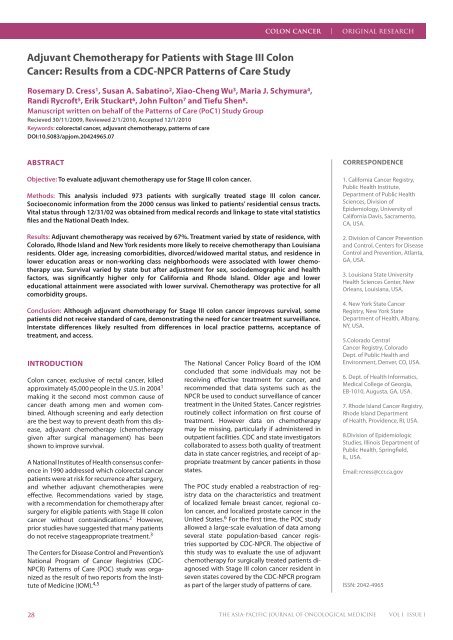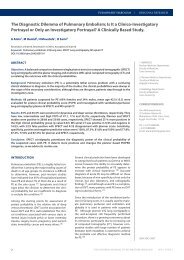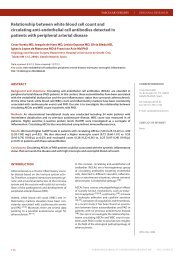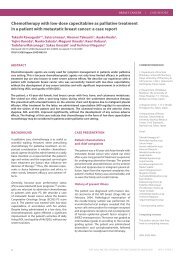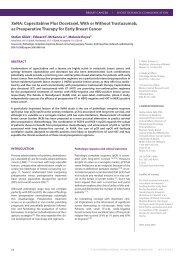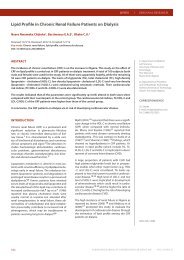Adjuvant Chemotherapy for Patients with Stage III Colon Cancer ...
Adjuvant Chemotherapy for Patients with Stage III Colon Cancer ...
Adjuvant Chemotherapy for Patients with Stage III Colon Cancer ...
You also want an ePaper? Increase the reach of your titles
YUMPU automatically turns print PDFs into web optimized ePapers that Google loves.
COLON CANCER | ORIGINAL RESEARCH<br />
<strong>Adjuvant</strong> <strong>Chemotherapy</strong> <strong>for</strong> <strong>Patients</strong> <strong>with</strong> <strong>Stage</strong> <strong>III</strong> <strong>Colon</strong><br />
<strong>Cancer</strong>: Results from a CDC-NPCR Patterns of Care Study<br />
Rosemary D. Cress 1 , Susan A. Sabatino 2 , Xiao-Cheng Wu 3 , Maria J. Schymura 4 ,<br />
Randi Rycroft 5 , Erik Stuckart 6 , John Fulton 7 and Tiefu Shen 8 .<br />
Manuscript written on behalf of the Patterns of Care (PoC1) Study Group<br />
Recieved 30/11/2009, Reviewed 2/1/2010, Accepted 12/1/2010<br />
Keywords: colorectal cancer, adjuvant chemotherapy, patterns of care<br />
DOI:10.5083/apjom.20424965.07<br />
ABSTRACT<br />
Objective: To evaluate adjuvant chemotherapy use <strong>for</strong> <strong>Stage</strong> <strong>III</strong> colon cancer.<br />
Methods: This analysis included 973 patients <strong>with</strong> surgically treated stage <strong>III</strong> colon cancer.<br />
Socioeconomic in<strong>for</strong>mation from the 2000 census was linked to patients’ residential census tracts.<br />
Vital status through 12/31/02 was obtained from medical records and linkage to state vital statistics<br />
files and the National Death Index.<br />
Results: <strong>Adjuvant</strong> chemotherapy was received by 67%. Treatment varied by state of residence, <strong>with</strong><br />
Colorado, Rhode Island and New York residents more likely to receive chemotherapy than Louisiana<br />
residents. Older age, increasing comorbidities, divorced/widowed marital status, and residence in<br />
lower education areas or non-working class neighborhoods were associated <strong>with</strong> lower chemotherapy<br />
use. Survival varied by state but after adjustment <strong>for</strong> sex, sociodemographic and health<br />
factors, was significantly higher only <strong>for</strong> Cali<strong>for</strong>nia and Rhode Island. Older age and lower<br />
educational attainment were associated <strong>with</strong> lower survival. <strong>Chemotherapy</strong> was protective <strong>for</strong> all<br />
comorbidity groups.<br />
Conclusion: Although adjuvant chemotherapy <strong>for</strong> <strong>Stage</strong> <strong>III</strong> colon cancer improves survival, some<br />
patients did not receive standard of care, demonstrating the need <strong>for</strong> cancer treatment surveillance.<br />
Interstate differences likely resulted from differences in local practice patterns, acceptance of<br />
treatment, and access.<br />
INTRODUCTION<br />
<strong>Colon</strong> cancer, exclusive of rectal cancer, killed<br />
approximately 45,000 people in the U.S. in 2004 1<br />
making it the second most common cause of<br />
cancer death among men and women combined.<br />
Although screening and early detection<br />
are the best way to prevent death from this disease,<br />
adjuvant chemotherapy (chemotherapy<br />
given after surgical management) has been<br />
shown to improve survival.<br />
A National Institutes of Health consensus conference<br />
in 1990 addressed which colorectal cancer<br />
patients were at risk <strong>for</strong> recurrence after surgery,<br />
and whether adjuvant chemotherapies were<br />
effective. Recommendations varied by stage,<br />
<strong>with</strong> a recommendation <strong>for</strong> chemotherapy after<br />
surgery <strong>for</strong> eligible patients <strong>with</strong> <strong>Stage</strong> <strong>III</strong> colon<br />
cancer <strong>with</strong>out contraindications. 2 However,<br />
prior studies have suggested that many patients<br />
do not receive stageappropriate treatment. 3<br />
The Centers <strong>for</strong> Disease Control and Prevention’s<br />
National Program of <strong>Cancer</strong> Registries (CDC-<br />
NPCR) Patterns of Care (POC) study was organized<br />
as the result of two reports from the Institute<br />
of Medicine (IOM). 4,5<br />
The National <strong>Cancer</strong> Policy Board of the IOM<br />
concluded that some individuals may not be<br />
receiving effective treatment <strong>for</strong> cancer, and<br />
recommended that data systems such as the<br />
NPCR be used to conduct surveillance of cancer<br />
treatment in the United States. <strong>Cancer</strong> registries<br />
routinely collect in<strong>for</strong>mation on first course of<br />
treatment. However data on chemotherapy<br />
may be missing, particularly if administered in<br />
outpatient facilities. CDC and state investigators<br />
collaborated to assess both quality of treatment<br />
data in state cancer registries, and receipt of appropriate<br />
treatment by cancer patients in those<br />
states.<br />
The POC study enabled a reabstraction of registry<br />
data on the characteristics and treatment<br />
of localized female breast cancer, regional colon<br />
cancer, and localized prostate cancer in the<br />
United States. 6 For the first time, the POC study<br />
allowed a large-scale evaluation of data among<br />
several state population-based cancer registries<br />
supported by CDC-NPCR. The objective of<br />
this study was to evaluate the use of adjuvant<br />
chemotherapy <strong>for</strong> surgically treated patients diagnosed<br />
<strong>with</strong> <strong>Stage</strong> <strong>III</strong> colon cancer resident in<br />
seven states covered by the CDC-NPCR program<br />
as part of the larger study of patterns of care.<br />
CORRESPONDENCE<br />
1. Cali<strong>for</strong>nia <strong>Cancer</strong> Registry,<br />
Public Health Institute,<br />
Department of Public Health<br />
Sciences, Division of<br />
Epidemiology, University of<br />
Cali<strong>for</strong>nia Davis, Sacramento,<br />
CA, USA.<br />
2. Division of <strong>Cancer</strong> Prevention<br />
and Control, Centers <strong>for</strong> Disease<br />
Control and Prevention, Atlanta,<br />
GA, USA.<br />
3. Louisiana State University<br />
Health Sciences Center, New<br />
Orleans, Louisiana, USA.<br />
4. New York State <strong>Cancer</strong><br />
Registry, New York State<br />
Department of Health, Albany,<br />
NY, USA.<br />
5.Colorado Central<br />
<strong>Cancer</strong> Registry, Colorado<br />
Dept. of Public Health and<br />
Environment, Denver, CO, USA.<br />
6. Dept. of Health In<strong>for</strong>matics,<br />
Medical College of Georgia,<br />
EB-1010, Augusta, GA, USA.<br />
7. Rhode Island <strong>Cancer</strong> Registry,<br />
Rhode Island Department<br />
of Health, Providence, RI, USA.<br />
8.Division of Epidemiologic<br />
Studies, Illinois Department of<br />
Public Health, Springfield,<br />
IL, USA.<br />
Email: rcress@ccr.ca.gov<br />
ISSN: 2042-4965<br />
28 THE ASIA-PACIFIC JOURNAL OF ONCOLOGICAL MEDICINE VOL I ISSUE I
ADJUVANT CHEMOTHERAPY FOR PATIENTS WITH STAGE <strong>III</strong> COLON CANCER: RESULTS FROM A CDC-NPCR PATTERNS OF CARE STUDY<br />
METHODS<br />
Administered by CDC, NPCR collects data on cancer incidence<br />
through central cancer registries in 45 states, the District of Columbia,<br />
Puerto Rico, the Republic of Palau and the Virgin Islands. In this<br />
study, staff from seven population-based state cancer registries<br />
(Cali<strong>for</strong>nia, Colorado, Illinois, Louisiana, New York, South Carolina,<br />
Rhode Island) collected supplemental treatment data <strong>for</strong> a random<br />
sample of cancer patients diagnosed in 1997. 7<br />
<strong>Patients</strong> included in the current analysis were those diagnosed <strong>with</strong><br />
a first primary <strong>Stage</strong> <strong>III</strong> colon cancer (ICD-O site codes C18.0–18.9),<br />
defined as American Joint Commission on <strong>Cancer</strong> pathology stage<br />
at diagnosis of 3, 3A, 3B, 3C and Summary <strong>Stage</strong> 3 or 4 according<br />
to SEER Summary <strong>Stage</strong> 1977. 8 Only patients <strong>with</strong> adenocarcinoma<br />
or adenosquamous carcinoma who received surgical treatment <strong>for</strong><br />
their colon cancer were included. <strong>Patients</strong> diagnosed <strong>with</strong> a subsequent<br />
cancer <strong>with</strong>in four months of their colon cancer diagnosis,<br />
and patients whose date of death or last contact was <strong>with</strong>in 30 days<br />
of surgery, were excluded.<br />
Trained abstractors gathered in<strong>for</strong>mation on treatment and other<br />
factors from patient medical records, including hospital charts and<br />
records from physician offices, ambulatory surgery and radiation<br />
therapy facilities. ICD-9-CM codes recorded in medical records were<br />
extracted to assess the presence of comorbid illness, which would<br />
influence receipt of treatment. Comorbid illness burden was assessed<br />
using the Charlson comorbidity index, which yields a score<br />
based on the number of conditions present, and the weight <strong>for</strong> that<br />
condition.<br />
Codes <strong>for</strong> the 17 conditions that make up the Charlson index were<br />
consolidated into a summary Charlson measure. 9 Race and ethnicity<br />
in<strong>for</strong>mation was combined to create four groups: Hispanic,<br />
non-Hispanic white, non-Hispanic black, and non-Hispanic other<br />
(including Asian/Pacific Islander) or unknown. <strong>Patients</strong> were categorized<br />
as non-Hispanic unless there was evidence to the contrary.<br />
Each patient’s address at the time of diagnosis was geocoded to<br />
the appropriate census tract <strong>with</strong>in the state of residence. In<strong>for</strong>mation<br />
on socioeconomic status (poverty, education and occupation)<br />
and urban vs. rural residence from the 2000 census was assigned<br />
to each census tract and linked to the patient’s census tract of residence.<br />
<strong>Patients</strong> residing in census tracts where fewer than 25% of<br />
adults had a high school education were classified as of lower education<br />
attainment; those residing in census tracts where at least<br />
66% of adults were in a working class occupation were classified<br />
as working class; and those residing in census tracts where at least<br />
20% of residents lived below the 2000 Federal Poverty Level were<br />
classified as in poverty. 10<br />
Insurance status was determined from medical records. Private insurance<br />
included those <strong>with</strong> either private insurance or Medicare<br />
<strong>with</strong> a supplement. Public insurance included those <strong>with</strong> Medicare,<br />
Medicaid or welfare, or other federally funded health insurance. Vital<br />
status as of 12/31/02 was obtained from medical records and<br />
physician offices, and was enhanced by linking to state vital statistics<br />
files and to the National Death Index.<br />
ANALYSIS<br />
We examined the proportions of patients receiving adjuvant chemotherapy<br />
by sociodemographic and health factors <strong>for</strong> the entire<br />
sample and after stratifying by sex. Fifty-eight patients who were<br />
missing in<strong>for</strong>mation about receipt of chemotherapy were excluded<br />
from the analysis of treatment receipt. In addition, we used multivariable<br />
logistic regression modeling to examine the crude and adjusted<br />
odds ratios <strong>with</strong> 95% confidence intervals of receiving adjuvant<br />
chemotherapy. Odds ratios were adjusted <strong>for</strong> age at diagnosis,<br />
sex, race/ethnicity, marital status, registry, health insurance, urbanrural<br />
residence, poverty, education, working class status, and Charlson<br />
comorbidity score. Model goodness of fit was tested <strong>with</strong> the<br />
Hosmer-Lemeshow test. Reference categories were generally chosen<br />
to be those <strong>with</strong> the greatest numbers, except where selected<br />
to facilitate comparisons <strong>with</strong> other studies.<br />
Finally, we examined survival from diagnosis through December<br />
31, 2002. First, we estimated the proportion of patients surviving<br />
5 years by receipt of chemotherapy, sex, sociodemographic and<br />
health factors. In addition, we used Cox proportional hazards models<br />
to estimate crude and adjusted hazards ratios <strong>with</strong> 95% confidence<br />
intervals, adjusting <strong>for</strong> all factors. We considered death due<br />
to any cause as an event. Because patients who received chemotherapy<br />
survived at least long enough to receive treatment, a timevarying<br />
covariate <strong>for</strong> receipt of adjuvant chemotherapy was included<br />
in the models to reduce potential bias. Time-varying covariates<br />
also were used to test the proportional hazards assumption, which<br />
was violated <strong>for</strong> age at diagnosis. There<strong>for</strong>e a time-varying covariate<br />
<strong>for</strong> age was kept in the model. We also examined an interaction<br />
between receiving adjuvant chemotherapy and comorbidity<br />
status. For dates, missing in<strong>for</strong>mation about day of the month<br />
(n = 27) was coded to 15 <strong>for</strong> February and to 16 <strong>for</strong> all other months.<br />
Missing in<strong>for</strong>mation about month (n = 1) was left as missing. SAS<br />
statistical software (version 9.1, SAS Institute, Cary, NC) was used in<br />
all analyses. P values < 0.05 were considered statistically significant.<br />
RESULTS<br />
A total of 1066 patients <strong>with</strong> <strong>Stage</strong> <strong>III</strong> colon cancer were identified.<br />
<strong>Patients</strong> <strong>with</strong> histologic types other than adenocarcinoma or adenosquamous<br />
carcinoma were excluded (n = 5) as well as one patient<br />
who did not receive surgical treatment, 20 patients diagnosed<br />
<strong>with</strong> a subsequent cancer <strong>with</strong>in four months of their colon cancer<br />
diagnosis, and 67 patients whose date of death or last contact was<br />
<strong>with</strong>in 30 days of surgery. Our final sample included 973 patients.<br />
Characteristics of the study population are shown in Table 1. Slightly<br />
more than half (53%) were female and the majority of patients were<br />
non-Hispanic white (76%), aged 65 or older (61%), and lived in urban<br />
areas (67%). Most had private insurance (69%) and the majority<br />
had no indication of comorbid illness in the medical record (75%).<br />
<strong>Patients</strong> were classified as being treated if in<strong>for</strong>mation in the medical<br />
record indicated they had received any chemotherapy. Table 2<br />
shows the unadjusted percent distributions of receipt of chemotherapy<br />
by sociodemographic and health factors. A total of 67% of<br />
eligible patients had a record of receipt of adjuvant chemotherapy.<br />
<strong>Patients</strong> under age 50 had the highest proportion of treatment<br />
(86%) and this declined to 41% among patients aged 75 and older.<br />
Differences in treatment by race group were non-significant; receipt<br />
of adjuvant chemotherapy was slightly higher among males than<br />
females in all race groups except non-Hispanic blacks where women<br />
had a higher rate of treatment.<br />
THE ASIA-PACIFIC JOURNAL OF ONCOLOGICAL MEDICINE<br />
VOL I ISSUE I<br />
29
HEALTHCARE BULLETIN | COLON CANCER<br />
Table 1. Distribution of patients <strong>with</strong> stage II colon cancer by sex,<br />
sociodemographic and health factors in selected areas of the United States, 1997 (n = 973).<br />
30<br />
THE ASIA-PACIFIC JOURNAL OF ONCOLOGICAL MEDICINE<br />
VOL I ISSUE I
ADJUVANT CHEMOTHERAPY FOR PATIENTS WITH STAGE <strong>III</strong> COLON CANCER: RESULTS FROM A CDC-NPCR PATTERNS OF CARE STUDY<br />
Table 1. (continued)<br />
a Other includes divorced, separated, and widowed. b Private insurance includes those <strong>with</strong> private insurance or Medicare <strong>with</strong> supplement.<br />
Public insurance includes those <strong>with</strong> Medicare, Medicaid or welfare, or other federally funded health insurance.<br />
c Data derived from the 2000 U.S. Census according to the census tract of the patient’s address.<br />
d In poverty includes adults residing in census tracts where at least 20% of residents lived below the 2000 Federal Poverty Level.<br />
e Higher educational attainment includes adults residing in areas where < 25% of adults have less than a high school education. Lower educational<br />
attainment includes adults residing in areas where > 25% of adults have less than a high school education.<br />
f Non-working class includes adults residing in areas where < 66% of adults are in a working class occupation. Working class includes adults residing in<br />
areas where > 66% of adults are in a working class occupation. g Determined by Charlson score.<br />
<strong>Patients</strong> under age 50 had the highest proportion of treatment<br />
(86%) and this declined to 41% among patients aged 75 and older.<br />
Differences in treatment by race group were non-significant; receipt<br />
of adjuvant chemotherapy was slightly higher among males than<br />
females in all race groups except non-Hispanic blacks where women<br />
had a higher rate of treatment. The proportion of patients treated<br />
was higher <strong>for</strong> married patients. The proportion of patients who<br />
received adjuvant chemotherapy varied by their state of residence,<br />
from 59% to 73%, although differences were not statistically significant.<br />
<strong>Patients</strong> <strong>with</strong> public insurance had the lowest likelihood of<br />
treatment, while those <strong>with</strong> no known health insurance had a higher<br />
proportion of treatment, although only a small number of patients<br />
were included in this category. <strong>Patients</strong> residing in rural communities<br />
had a non-significantly higher likelihood of treatment, as<br />
did patients residing in census tracts where a higher proportion<br />
of residents were educated. <strong>Patients</strong> <strong>with</strong> two or more comorbid<br />
illnesses recorded in their medical records were less likely to have<br />
received adjuvant treatment than those <strong>with</strong> no comorbid illness.<br />
Crude and adjusted odds ratios <strong>for</strong> receipt of adjuvant chemotherapy<br />
in this population are shown in Table 3. After adjustment <strong>for</strong><br />
other variables, state of residence was the strongest predictor of<br />
receipt of adjuvant treatment, and patients residing in three states<br />
(Colorado, Rhode Island, New York) were about twice as likely as<br />
those in the reference state (Louisiana) to have received treatment.<br />
Age also was a powerful predictor of receipt of adjuvant treatment,<br />
and patients aged 75 and older were only 24% as likely to have received<br />
this treatment compared to those aged 65 to 74. <strong>Patients</strong><br />
<strong>with</strong> two or more comorbid illnesses were about one-third as likely<br />
as those <strong>with</strong> no comorbidity to have received treatment. Divorced<br />
or widowed patients were about half as likely as married patients<br />
to have received treatment. <strong>Patients</strong> who lived in census tracts<br />
<strong>with</strong> lower educational attainment were less likely to have received<br />
adjuvant therapy, however those living in working class neighborhoods<br />
were more likely to have received treatment after adjusting<br />
<strong>for</strong> other factors, and census tract level of poverty did not affect<br />
probability of treatment. Race/ethnicity, gender, urban/rural residence,<br />
and health insurance did not have a statistically significant<br />
effect on treatment after adjustment <strong>for</strong> other variables.<br />
Five year survival rates and crude and adjusted hazard ratios are<br />
shown in Table 4. Eighty-nine patients were missing in<strong>for</strong>mation<br />
<strong>for</strong> the time-varying covariate or receipt of adjuvant chemotherapy<br />
and were excluded from all survival analyses. One additional<br />
individual was missing in<strong>for</strong>mation about date of diagnosis, and<br />
there<strong>for</strong>e survival time could not be calculated. There<strong>for</strong>e, data <strong>for</strong><br />
these analyses were available from 883 patients. <strong>Patients</strong> aged 75<br />
and older had a substantially higher risk of death from any cause<br />
in five years, and men had a higher risk of dying than did women<br />
(p = 0.06).<br />
Formerly married patients had a higher risk of death but this was<br />
not statistically significant after adjustment <strong>for</strong> age and other factors.<br />
Five year survival rates varied by state of residence, from 45%<br />
to 63%, but the hazard ratio was statistically significantly lower (survival<br />
significantly higher) only <strong>for</strong> Cali<strong>for</strong>nia and Rhode Island after<br />
adjustment <strong>for</strong> other factors. <strong>Patients</strong> <strong>with</strong> public insurance or <strong>with</strong>out<br />
insurance had a higher risk of death than those <strong>with</strong> private<br />
insurance, but again this result was not statistically significant after<br />
adjustment. <strong>Patients</strong> <strong>with</strong> lower educational attainment also had a<br />
higher risk of death than those <strong>with</strong> higher educational attainment.<br />
Crude hazard ratios show that patients <strong>with</strong> any comorbid condition<br />
were more likely to die than those <strong>with</strong> no comorbid illnesses,<br />
and those <strong>with</strong> two or more comorbid illnesses were approximately<br />
twice as likely to die.<br />
Unadjusted findings indicate that almost twice as many patients<br />
who received adjuvant chemotherapy survived five years (61% versus<br />
33%). In multivariate analysis, a statistically significant interaction<br />
was found between receipt of adjuvant therapy and comorbidity<br />
status (p < 0.025). Receiving chemotherapy was protective in all<br />
comorbidity groups, <strong>with</strong> the strongest effect among patients <strong>with</strong><br />
a Charlson score of one.<br />
Among those who received chemotherapy, increasing comorbid<br />
illness burden was not associated <strong>with</strong> significantly lower survival.<br />
However among patients who did not receive chemotherapy, patients<br />
<strong>with</strong> comorbid illnesses had lower survival than patients <strong>with</strong><br />
no comorbidities. No statistically significant differences in survival<br />
were observed <strong>for</strong> race, urban/rural residence, or census based poverty<br />
status.<br />
DISCUSSION<br />
Despite the powerful evidence that chemotherapy after surgery <strong>for</strong><br />
<strong>Stage</strong> <strong>III</strong> colon cancer can improve survival, results of this study confirm<br />
previous studies that suggested that some groups of patients<br />
do not receive standard of care <strong>for</strong> this disease. Similar to other<br />
studies, age, marital status and comorbidity were major predictors<br />
of receipt of chemotherapy. 11 For some individuals, adjuvant chemotherapy<br />
may not have been given due to contraindications from<br />
concurrent medical conditions. Our survival model suggested that<br />
adjuvant chemotherapy was protective among patients <strong>with</strong> and<br />
<strong>with</strong>out comorbidities, and there<strong>for</strong>e seemed to suggest that, at<br />
least <strong>for</strong> some patients <strong>with</strong> higher comorbid illness burdens, adjuvant<br />
treatment can be protective. However, we did not have detailed<br />
in<strong>for</strong>mation about severity of comorbid conditions <strong>with</strong>in the<br />
categories used in our analysis to examine this further. Geographic<br />
differences by state persisted after adjustment <strong>for</strong> other factors,<br />
and have not been studied as extensively. Interstate differences in<br />
receipt of treatment are likely a result of local practice patterns, lack<br />
of uni<strong>for</strong>m acceptance of this treatment, and lack of access to treatment<br />
facilities.<br />
THE ASIA-PACIFIC JOURNAL OF ONCOLOGICAL MEDICINE<br />
VOL I ISSUE I<br />
31
HEALTHCARE BULLETIN | COLON CANCER<br />
Table 2. Proportion of patients <strong>with</strong> stage II colon cancer <strong>with</strong> known treatment status a receiving adjuvant chemotherapy,<br />
by sex, sociodemographic and health factors in selected areas of the United States, 1997 (n = 915).<br />
32<br />
THE ASIA-PACIFIC JOURNAL OF ONCOLOGICAL MEDICINE<br />
VOL I ISSUE I
ADJUVANT CHEMOTHERAPY FOR PATIENTS WITH STAGE <strong>III</strong> COLON CANCER: RESULTS FROM A CDC-NPCR PATTERNS OF CARE STUDY<br />
Table 2. (Continued)<br />
a 58 individuals missing in<strong>for</strong>mation about receipt of adjuvant chemotherapy, 2 individuals missing in<strong>for</strong>mation about residence, poverty,<br />
education and working class. b Formerly married includes divorced, separated, and widowed.<br />
c Private insurance includes those <strong>with</strong> private insurance or Medicare <strong>with</strong> supplement. Public insurance includes those <strong>with</strong> Medicare,<br />
Medicaid or welfare, or other federally funded health insurance. d Data derived from the 2000 U.S. Census according to the census tract of the patient’s address.<br />
e In poverty includes adults residing in census tracts where at least 20% of residents lived below the 2000 Federal Poverty Level.<br />
f Higher educational attainment includes adults residing in areas where < 25% of adults have less than a high school education.<br />
Lower educational attainment includes adults residing in areas where > 25% of adults have less than a high school education.<br />
g Non-working class includes adults residing in areas where < 66% of adults are in a working class occupation.<br />
Working class includes adults residing in areas where > 66% of adults are in a working class occupation.<br />
h Determined by Charlson score.<br />
Regional differences in receipt of treatment also were seen in an<br />
earlier Cali<strong>for</strong>nia study, 11 as well as variation by hospital. In a survey<br />
of physicians, the most common reasons cited <strong>for</strong> not providing adjuvant<br />
chemotherapy <strong>for</strong> <strong>Stage</strong> <strong>III</strong> colon cancer were patient refusal,<br />
comorbid illness, and lack of clinical indication. 11<br />
Despite NIH recommendations, over 20% of physicians reported<br />
that adjuvant chemotherapy was not clinically indicated <strong>for</strong> their<br />
<strong>Stage</strong> <strong>III</strong> colon cancer patients. 11 Interestingly, interstate differences<br />
in receipt of chemotherapy did not appear to correlate <strong>with</strong><br />
interstate differences in survival, and it is likely that other factors are<br />
involved. This may be attributable in part to differences by state in<br />
the number of cases excluded from the survival analysis. Survival<br />
after diagnosis <strong>for</strong> patients in this study was influenced by age, comorbid<br />
illness, and receipt of chemotherapy.<br />
Receipt of adjuvant treatment <strong>for</strong> patients in NPCR states appeared<br />
to be slightly, although not substantially, lower than <strong>for</strong> patients in<br />
areas covered by the National <strong>Cancer</strong> Institute’s Surveillance, Epidemiology<br />
and End Results (SEER) program. Results from SEER Patterns<br />
of Care studies reported that use of adjuvant chemotherapy<br />
<strong>for</strong> <strong>Stage</strong> <strong>III</strong> colon cancer increased between 1989 and 1990 when<br />
the NIH consensus conference was held, and has remained relatively<br />
stable since 1990. 12 Receipt of chemotherapy in 1995 by patients<br />
<strong>with</strong> <strong>Stage</strong> <strong>III</strong> colon cancer in the SEER study was 90% <strong>for</strong> patients<br />
aged 55 or younger.<br />
This is slightly higher than the 86% of patients aged 50 or younger<br />
in the current study diagnosed in 1997. There is some evidence that<br />
patients residing in SEER areas are somewhat more affluent than<br />
other areas of the U.S, 13 and they may have greater access to high<br />
quality cancer care. Receipt of treatment <strong>for</strong> older patients in the<br />
current study was comparable to that <strong>for</strong> similarly aged patients<br />
studied using linked SEER-Medicare data.<br />
Table 3. Crude and adjusted odds ratios <strong>for</strong> receipt of adjuvant chemotherapy <strong>for</strong> <strong>Stage</strong> II colon cancer, by sociodemographic<br />
and health factors in selected areas of the United States, 1997.<br />
Continued...<br />
THE ASIA-PACIFIC JOURNAL OF ONCOLOGICAL MEDICINE<br />
VOL I ISSUE I<br />
33
HEALTHCARE BULLETIN | COLON CANCER<br />
Table 3. (Continued)<br />
a 5 8 individuals missing in<strong>for</strong>mation about receipt of adjuvant chemotherapy.<br />
An additional 2 were missing in<strong>for</strong>mation about urban residence, poverty, education and working class.<br />
b Model 1 adjusted <strong>for</strong> age, sex, and race/ethnicity. Model 2 adjusted <strong>for</strong> all factors in the table.<br />
c Formerly married includes divorced, separated, and widowed.<br />
d Private insurance includes those <strong>with</strong> private insurance or Medicare <strong>with</strong> supplement.<br />
Public insurance includes those <strong>with</strong> Medicare, Medicaid or welfare, or other federally funded health insurance.<br />
e Data derived from the 2000 U.S. Census according to the census tract of the patient’s address.<br />
f In poverty includes adults residing in census tracts where at least 20% of residents lived below the 2000 Federal Poverty Level.<br />
g Higher educational attainment includes adults residing in areas where < 25% of adults have less than a high school education.<br />
Lower educational attainment includes adults residing in areas where > 25% of adults have less than a high school education.<br />
h Non-working class includes adults residing in areas where < 66% of adults are in a working class occupation.<br />
Working class includes adults residing in areas where > 66% of adults are in a working class occupation.<br />
i Determined by Charlson score.<br />
j p < 0.05<br />
34<br />
THE ASIA-PACIFIC JOURNAL OF ONCOLOGICAL MEDICINE<br />
VOL I ISSUE I
ADJUVANT CHEMOTHERAPY FOR PATIENTS WITH STAGE <strong>III</strong> COLON CANCER: RESULTS FROM A CDC-NPCR PATTERNS OF CARE STUDY<br />
Treatment rates <strong>for</strong> patients diagnosed <strong>with</strong> <strong>Stage</strong> <strong>III</strong> colon cancer<br />
between 1991 and 1996 and identified through the SEER program<br />
were 78% <strong>for</strong> those aged 65 to 69, and 74% <strong>for</strong> those aged 70–74,<br />
similar to the 75% <strong>for</strong> patients aged 65–74 in the current study diagnosed<br />
in 1997. 14 <strong>Patients</strong> residing in neighborhoods <strong>with</strong> less<br />
education were less likely to have received adjuvant chemotherapy,<br />
although residence in poor neighborhoods did not have a statistically<br />
significant effect after adjustment <strong>for</strong> other factors. <strong>Patients</strong><br />
residing in Treatment rates <strong>for</strong> patients diagnosed <strong>with</strong> <strong>Stage</strong> <strong>III</strong><br />
colon cancer between 1991 and 1996 and identified through the<br />
SEER program were 78% <strong>for</strong> those aged 65 to 69, and 74% <strong>for</strong> those<br />
aged 70–74, similar to the 75% <strong>for</strong> patients aged 65–74 in the current<br />
study diagnosed in 1997. 14<br />
<strong>Patients</strong> residing in neighborhoods <strong>with</strong> less education were less<br />
likely to have received adjuvant chemotherapy, although residence<br />
in poor neighborhoods did not have a statistically significant effect<br />
after adjustment <strong>for</strong> other factors. <strong>Patients</strong> residing in rural areas<br />
of the U.S. were not substantially less likely to have received treatment.<br />
<strong>Adjuvant</strong> chemotherapy is usually administered in outpatient<br />
treatment facilities and does not require the access to specialized<br />
treatment facilities required by adjuvant radiation treatment.<br />
Type of health insurance did not have a significant effect on receipt<br />
of treatment after adjustment <strong>for</strong> other factors, and did not influence<br />
survival. The majority of patients in the analysis were aged 65<br />
or older and would have been covered by Medicare.<br />
Table 4. Five-year survival and crude and adjusted hazard ratios <strong>for</strong> patients <strong>with</strong> stage II colon cancer by sex,<br />
sociodemographic and health factors in selected areas of the United States, 1997 (n = 883a).<br />
Continued...<br />
THE ASIA-PACIFIC JOURNAL OF ONCOLOGICAL MEDICINE<br />
VOL I ISSUE I<br />
35
HEALTHCARE BULLETIN | COLON CANCER<br />
Table 4. (Continued)<br />
a Adjusted <strong>for</strong> age and factors in the table. 90 individuals were missing in<strong>for</strong>mation about whether or not they received chemotherapy or the time interval<br />
between diagnosis to receipt of chemotherapy. An additional 2 individuals were missing in<strong>for</strong>mation about poverty, education, urban residence and working<br />
class. There<strong>for</strong>e <strong>for</strong> those factors, n = 881.<br />
b Formerly married includes divorced, separated, and widowed.<br />
c Private insurance includes those <strong>with</strong> private insurance or Medicare <strong>with</strong> supplement. Public insurance includes those <strong>with</strong> Medicare,<br />
Medicaid or welfare, or other federally funded health insurance.<br />
d Data derived from the 2000 U.S. Census according to the census tract of the patient’s address.<br />
e In poverty includes adults residing in census tracts where at least 20% of residents lived below the 2000 Federal Poverty Level.<br />
f Higher educational attainment includes adults residing in areas where < 25% of adults have less than a high school education.<br />
Lower educational attainment includes adults residing in areas where > 25% of adults have less than a high school education.<br />
g Non-working class includes adults residing in areas where < 66% of adults are in a working class occupation.<br />
Working class includes adults residing in areas where > 66% of adults are in a working class occupation.<br />
h Determined by Charlson score.<br />
i p < 0.05<br />
j interaction between comorbidity and adjuvant chemotherapy use significant, p < 0.05.<br />
36<br />
THE ASIA-PACIFIC JOURNAL OF ONCOLOGICAL MEDICINE<br />
VOL I ISSUE I
ADJUVANT CHEMOTHERAPY FOR PATIENTS WITH STAGE <strong>III</strong> COLON CANCER: RESULTS FROM A CDC-NPCR PATTERNS OF CARE STUDY<br />
Our study was subject to several limitations. First, data were collected<br />
from seven states and are there<strong>for</strong>e not necessarily generalizable<br />
to all states. Moreover, data <strong>for</strong> this study were collected five years<br />
after the cancer diagnosis year, and there<strong>for</strong>e some patient records<br />
were not retrievable. Additionally, completeness of chemotherapy<br />
data may vary by registry. Our measures of socioeconomic status<br />
were derived from Census data and were there<strong>for</strong>e not individuallevel<br />
data. Furthermore, we only collected comorbidities that had<br />
been coded on the face sheets of patients’ medical records. There<strong>for</strong>e,<br />
comorbidities may have been underreported. Finally, we were<br />
unable to examine cause-specific mortality in addition to overall<br />
mortality.<br />
The CDC-NPCR Patterns of Care study follows the National <strong>Cancer</strong><br />
Policy Board recommendation that data systems such as the NPCR<br />
be used to conduct surveillance of cancer treatment in the United<br />
States. The study demonstrated the need <strong>for</strong> surveillance of cancer<br />
treatment across the U.S. by confirming gaps in treatment <strong>for</strong> some<br />
groups. This study also documented the substantial challenges to<br />
treatment surveillance using cancer registry treatment data. Analysis<br />
of quality of registry treatment data <strong>for</strong> patients in this study<br />
showed that only about 71% of chemotherapy received by colon<br />
cancer patients was captured by cancer registries through routine<br />
data collection.6 Use of registries <strong>for</strong> treatment surveillance will<br />
continue to require that treatment contained in the NPCR registries,<br />
as in SEER registries, be supplemented <strong>with</strong> data collection in physician<br />
offices and other treatment facilities.<br />
REFERENCES<br />
1<br />
2<br />
3<br />
4<br />
5<br />
6<br />
7<br />
8<br />
U.S. <strong>Cancer</strong> Statistics Working Group. United States <strong>Cancer</strong> Statistics:<br />
1999–2004 Incidence and Mortality Web-based Report. Atlanta: U.S.<br />
Department of Health and Human Services, Centers <strong>for</strong> Disease Control<br />
and Prevention and National <strong>Cancer</strong> Institute, 2007.<br />
NIH consensus conference. <strong>Adjuvant</strong> therapy <strong>for</strong> patients<br />
<strong>with</strong> colon and rectal cancer. JAMA. 1990;264:1444–50.<br />
Hodgson DC, Fuchs CS, Ayanian JZ. Impact of patient and provider<br />
characteristics on the treatment and outcomes of colorectal cancer.<br />
J Natl <strong>Cancer</strong> Inst. 2001;93:501–15.<br />
Hewitt MaS, JV, eds. Ensuring Quality <strong>Cancer</strong> Care. Washington, DC:<br />
National Academy Press; 1999.<br />
Hewitt MaS JV, eds. Enhancing data systems to improve the quality of<br />
cancer care. Washington, DC: National Academy Press; 2000.<br />
German RR, Wike JM, Wolf HJ, et al. Quality of <strong>Cancer</strong> Registry Data:<br />
Findings From CDC-NPCR’s Breast, <strong>Colon</strong>, and Prostate <strong>Cancer</strong> Data<br />
Quality and Patterns of Care Study. Journal of Registry Management.<br />
2008;35(2):67–74.<br />
McDavid K, Schymura MJ, Armstrong L, et al. Rationale and<br />
design of the National Program of <strong>Cancer</strong> Registries’ Breast, <strong>Colon</strong>,<br />
and Prostate <strong>Cancer</strong> Patterns of Care Study. <strong>Cancer</strong> Causes Control.<br />
2004;15:1057–66.<br />
SEER Program: Comparative staging guide <strong>for</strong> cancer, version 1.1.<br />
Bethesda: National Institutes of Health, National <strong>Cancer</strong> Institute 1993.<br />
ACKNOWLEDGEMENTS<br />
The authors gratefully acknowledge all the abstractors and staff in<br />
the participating registries who worked collaboratively <strong>with</strong> staff<br />
in the CDC Division of <strong>Cancer</strong> Prevention and Control to develop<br />
and conduct this study. The authors would also like to acknowledge<br />
Trevor Thompson <strong>for</strong> biostatistical support.<br />
FINANCIAL SUPPORT<br />
This study was funded through cooperative agreements by the Division<br />
of <strong>Cancer</strong> Prevention and Control, National Center <strong>for</strong> Chronic<br />
Disease Prevention and Health Promotion, Centers <strong>for</strong> Disease<br />
Control and Prevention, Atlanta, Georgia.<br />
The findings and conclusions in this report are those of the authors<br />
and do not necessarily represent the official position of the Centers<br />
<strong>for</strong> Disease Control and Prevention. The collection of cancer<br />
incidence data used in this study was supported by the Cali<strong>for</strong>nia<br />
Department of Health Services as part of the statewide cancer reporting<br />
program mandated by Cali<strong>for</strong>nia Health and Safety Code<br />
Section 103885; the National <strong>Cancer</strong> Institute’s Surveillance, Epidemiology<br />
and End Results Program under contract N01-PC-35136<br />
awarded to the Northern Cali<strong>for</strong>nia <strong>Cancer</strong> Center, contract N01-<br />
PC-35139 awarded to the University of Southern Cali<strong>for</strong>nia, and<br />
contract N02-PC-15105 awarded to the Public Health Institute; and<br />
the Centers <strong>for</strong> Disease Control and Prevention’s National Program<br />
of <strong>Cancer</strong> Registries, under agreement #U55/CCR921930-02 awarded<br />
to the Public Health Institute. The ideas and opinions expressed<br />
herein are those of the author(s) and endorsement by the State of<br />
Cali<strong>for</strong>nia, Department of Health Services, the National <strong>Cancer</strong> Institute,<br />
and the Centers <strong>for</strong> Disease Control and Prevention or their<br />
Contractors and Subcontractors is not intended nor should be inferred<br />
9<br />
10<br />
11<br />
12<br />
13<br />
14<br />
15<br />
Deyo RA, Cherkin DC, Ciol MA. Adapting a clinical comorbidity index<br />
<strong>for</strong> use <strong>with</strong> ICD-9-CM administrative databases. J Clin Epidemiol. 1992;<br />
45:613–9.<br />
Krieger N. Overcoming the absence of socioeconomic data in medical<br />
records: validation and application of a census-based methodology.<br />
Am J Public Health. 1992;82:703–10.<br />
Ayanian JZ, Zaslavsky AM, Fuchs CS, et al. Use of adjuvant chemotherapy<br />
and radiation therapy <strong>for</strong> colorectal cancer in a population-based<br />
cohort. J Clin Oncol. 2003;21:1293–300.<br />
Potosky AL, Harlan LC, Kaplan RS, et al. Age, sex, and racial differences<br />
in the use of standard adjuvant therapy <strong>for</strong> colorectal cancer. J Clin<br />
Oncol. 2002;20:1192–202.<br />
Warren JL, Klabunde CN, Schrag D, et al. Overview of the<br />
SEER-Medicare data: content, research applications, and<br />
generalizability to the United States elderly population.<br />
Med Care. 2002;40:IV-3–18.<br />
Schrag D, Cramer LD, Bach PB, et al. Age and adjuvant<br />
chemotherapy use after surgery <strong>for</strong> stage <strong>III</strong> colon cancer.<br />
J Natl <strong>Cancer</strong> Inst. 2001;93:850–7.<br />
Originally published in Clinical Medicine: Oncology 2009:3 107- 119<br />
THE ASIA-PACIFIC JOURNAL OF ONCOLOGICAL MEDICINE<br />
VOL I ISSUE I<br />
37


